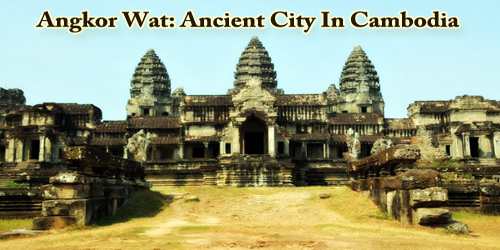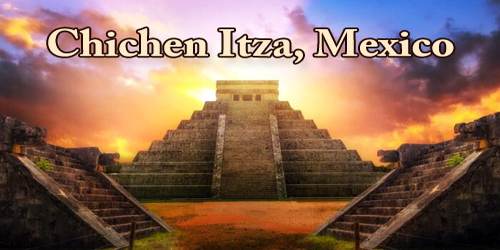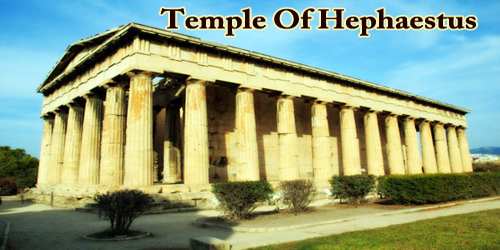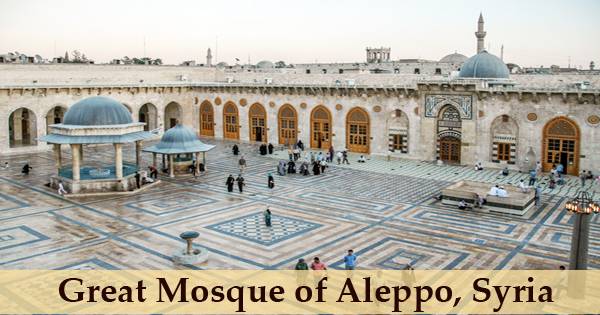Angkor Wat (/ˌæŋkɔːr ˈwɒt/; Khmer: អង្គរវត្ត, “City/Capital of Temples”) is one of the most important archaeological sites in South-East Asia. Stretching over some 400 km2, including forested area, Angkor Archaeological Park contains the magnificent remains of the different capitals of the Khmer Empire, from the 9th to the 15th century. They include the famous Temple of Angkor Wat and, at Angkor Thom, the Bayon Temple with its countless sculptural decorations.
Angkor Wat is a Buddhist temple complex in Cambodia and is the largest religious monument in the world, on a site measuring 162.6 hectares (1,626,000 m2; 402 acres). Originally constructed as a Hindu temple dedicated to the god Vishnu for the Khmer Empire, it was gradually transformed into a Buddhist temple towards the end of the 12th century (113-5BC). It was built by the Khmer King Suryavarman II in the early 12th century in Yaśodharapura (Khmer: យសោធរបុរៈ, present-day Angkor), the capital of the Khmer Empire, as his state temple and eventual mausoleum. Breaking from the Shaiva tradition of previous kings, Angkor Wat was instead dedicated to Vishnu. As the best-preserved temple at the site, it is the only one to have remained a significant religious centre since its foundation. The temple is at the top of the high classical style of Khmer architecture. It has become a symbol of Cambodia, appearing on its national flag, and it is the country’s prime attraction for visitors.
Although it is no longer an active temple, it serves as an important tourist attraction in Cambodia, despite the fact it sustained significant damage during the autocratic rule of the Khmer Rouge regime in the 1970s and in earlier regional conflicts.
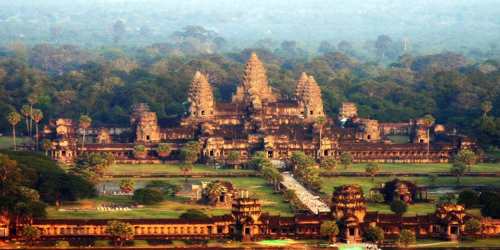
Angkor Wat combines two basic plans of Khmer temple architecture: the temple-mountain and the later galleried temple. It is designed to represent Mount Meru, home of the devas in Hindu mythology: within a moat more than 5 kilometres (3 mi) long and an outer wall 3.6 kilometres (2.2 mi) long are three rectangular galleries, each raised above the next. At the centre of the temple stands a quincunx of towers. Unlike most Angkorian temples, Angkor Wat is oriented to the west; scholars are divided as to the significance of this. The temple is admired for the grandeur and harmony of the architecture, its extensive bas-reliefs, and for the numerous devatas adorning its walls.
Angkor Wat, the largest monument of the Angkor group and the best preserved, is an architectural masterpiece. Its perfection in composition, balance, proportions, relief’s and sculpture make it one of the finest monuments in the world.
Wat is the Khmer name for temple (the French spelling is “vat”), which was probably added to “Angkor” when it became a Theravada Buddhist monument, most likely in the sixteenth century. After 1432 when the capital moved to Phnom Penh, Angkor Wat was cared for by Buddhist monks. It is generally accepted that Angkor Wat was a funerary temple for King Suryavarman II and oriented to the west to conform to the symbolism between the setting sun and death. The bas-reliefs, designed for viewing from left to right in the order of Hindu funereal ritual, support this function.
The modern name, Angkor Wat (Khmer: អង្គរវត្ត) (alternate name: Nokor Wat, Khmer: នគរវត្ត), means “Temple City” or “City of Temples” in Khmer; Angkor (Khmer: អង្គរ) meaning “city” or “capital city”, is a vernacular form of the word nokor (Khmer: នគរ), which comes from the Sanskrit word nagara (Devanāgarī: नगर). Wat (Khmer: វត្ត) is the Khmer word for “temple grounds”, also derived from Sanskrit vāṭa (Devanāgarī: वाट), meaning “enclosure”.
The original name of the temple was Vrah Viṣṇuloka or Parama Viṣṇuloka (Sanskrit), (Khmer: បរមវិស្ណុលោក – Barom Visnulōk) which means the sacred dwelling of Vishnu.
Angkor Wat is located roughly five miles north of the modern Cambodian city of Siem Reap, which has a population of more than 200,000 people. In an area of Cambodia where there is an important group of ancient structures, it is the southernmost of Angkor’s main sites.
The initial design and construction of the temple took place in the first half of the 12th century, during the reign of Suryavarman II (ruled 1113 – c. 1150). Dedicated to Vishnu, it was built as the king’s state temple and capital city. As neither the foundation stela nor any contemporary inscriptions referring to the temple have been found, its original name is unknown, but it may have been known as “Varah Vishnu-lok” after the presiding deity. Work seems to have ended shortly after the king’s death, leaving some of the bas-relief decoration unfinished. In 1177, approximately 27 years after the death of Suryavarman II, Angkor was sacked by the Chams, the traditional enemies of the Khmer. Thereafter the empire was restored by a new king, Jayavarman VII, who established a new capital and state temple (Angkor Thom and the Bayon respectively) a few kilometres to the north.
Angkor Wat is a miniature replica of the universe in stone and represents an earthly model of the cosmic world. The central tower rises from the center of the monument symbolizing the mythical mountain, Meru, situated at the center of the universe. Its five towers correspond to the peaks of Meru. The outer wall corresponds to the mountains at the edge of the world, and the surrounding moat the oceans beyond.
Towards the end of the 12th century, Angkor Wat gradually transformed from a Hindu centre of worship to Buddhism, which continues to the present day. Angkor Wat is unusual among the Angkor temples in that although it was largely neglected after the 16th century it was never completely abandoned. Fourteen inscriptions dated from the 17th century discovered in Angkor area testify to Japanese Buddhist pilgrims that had established small settlements alongside Khmer locals. At that time, the temple was thought by the Japanese visitors as the famed Jetavana garden of the Buddha, which originally located in the kingdom of Magadha, India. The best-known inscription tells of Ukondayu Kazufusa, who celebrated the Khmer New Year at Angkor Wat in 1632.
Although Angkor Wat was no longer a site of political, cultural or commercial significance by the 13th century, it remained an important monument for the Buddhist religion into the 1800s.
Indeed, unlike many historical sites, Angkor Wat was never truly abandoned. Rather, it fell gradually into disuse and disrepair.
Nonetheless, it remained an architectural marvel unlike anything else. It was “rediscovered” in 1840s by the French explorer Henri Mouhot, who wrote that the site was “grander than anything left to us by Greece or Rome.”
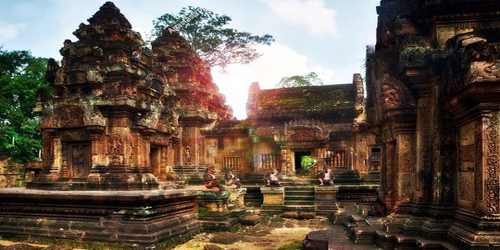
One of the first Western visitors to the temple was António da Madalena, a Portuguese friar who visited in 1586 and said that “it is of such extraordinary construction that it is not possible to describe it with a pen, particularly since it is like no other building in the world. It has towers and decoration and all the refinements which the human genius can conceive of.”
In the mid-19th century, the temple was effectively rediscovered by the French naturalist and explorer Henri Mouhot in 1860, who popularized the site in the West through the publication of travel notes, in which he wrote:
“One of these temples, a rival to that of Solomon, and erected by some ancient Michelangelo, might take an honorable place beside our most beautiful buildings. It is grander than anything left to us by Greece or Rome, and presents a sad contrast to the state of barbarism in which the nation is now plunged.”
Angkor Wat occupies a rectangular area of about 208 hectares (500 acres) defined by a laetrile wall. The first evidence of the site is a moat with a long sandstone causeway (length 250 meters, 820 feet; width 12 meters, 39 feet) crossing it and serving as the main access to the monument. The moat is 200 meters (656 feel) wide with a perimeter of 5.5 kilometers (3.4 miles).
The temple walls are decorated with thousands of bas-reliefs representing important deities and figures in the Hindu and Buddhist religions as well as key events in its narrative tradition. There is also a bas-relief depicting Emperor Suryavarman II entering the city, perhaps for the first time following its construction.
The 20th century saw considerable restoration of Angkor Wat. Gradually teams of laborers and archeologists pushed back the jungle and exposed the expanses of stone, permitting the sun once again to illuminate the dark corners of the temple. Work was interrupted by the Cambodian Civil War and Khmer Rouge control of the country during the 1970s and 1980s, but relatively little damage was done during this period. Camping Khmer Rouge forces used whatever wood remained in the building structures for firewood, and a shoot-out between Khmer Rouge and Vietnamese forces put a few bullet holes in a bas relief. Far more damage was done after the wars, by art thieves working out of Thailand, which, in the late 1980s and early 1990s, claimed almost every head that could be lopped off the structures, including reconstructions.
In 1992, it was named a UNESCO World Heritage site. Although visitors to Angkor Wat numbered in just the few thousands at the time, the landmark now welcomes some 500,000 visitors each year many of whom arrive early in the morning to capture images of the sunrise over what still is a very magical, spiritual place.
In December 2015, it was announced that a research team from University of Sydney had found a previously unseen ensemble of buried towers built and demolished during the construction of Angkor Wat, as well as massive structure of unknown purpose on its south side and wooden fortifications. The findings also include evidence of low-density residential occupation in the region, with a road grid, ponds and mounds. These indicate that the temple precinct, bounded by moat and wall, may not have been used exclusively by the priestly elite, as was previously thought. The team used LiDAR, ground-penetrating radar and targeted excavation to map Angkor Wat.
The most popular temples are Angkor Wat, Bayon, Ta Phrom, and Angkor Thom, and they always have crowds. In order to really experience the temples, people will need to purchase the three or five-day pass. The best time to visit is early in the morning before the big tour groups arrive and stay late after they have gone.
Since the 1990s, Angkor Wat has become a major tourist destination. In 1993, there were only 7,650 visitors to the site; by 2004, government figures show that 561,000 foreign visitors had arrived in Siem Reap province that year, approximately 50% of all foreign tourists in Cambodia. The number reached over a million in 2007, and over two million by 2012. Most visited Angkor Wat, which received over two million foreign tourists in 2013, and 2.6 million by 2018.
The temples are about a 20 minute drive from Siem Reap. A 1-day pass is $37 USD, 3-day is $62 USD, and 7-day is $72 USD. There’s no real need to carry the local currency, Cambodian Riels (KHR), unless you paying for really small things on the street. People can rent a tuk-tuk driver for about $20 for a day to take them around or bike around their self. The area is too big to walk.
Information Sources:
